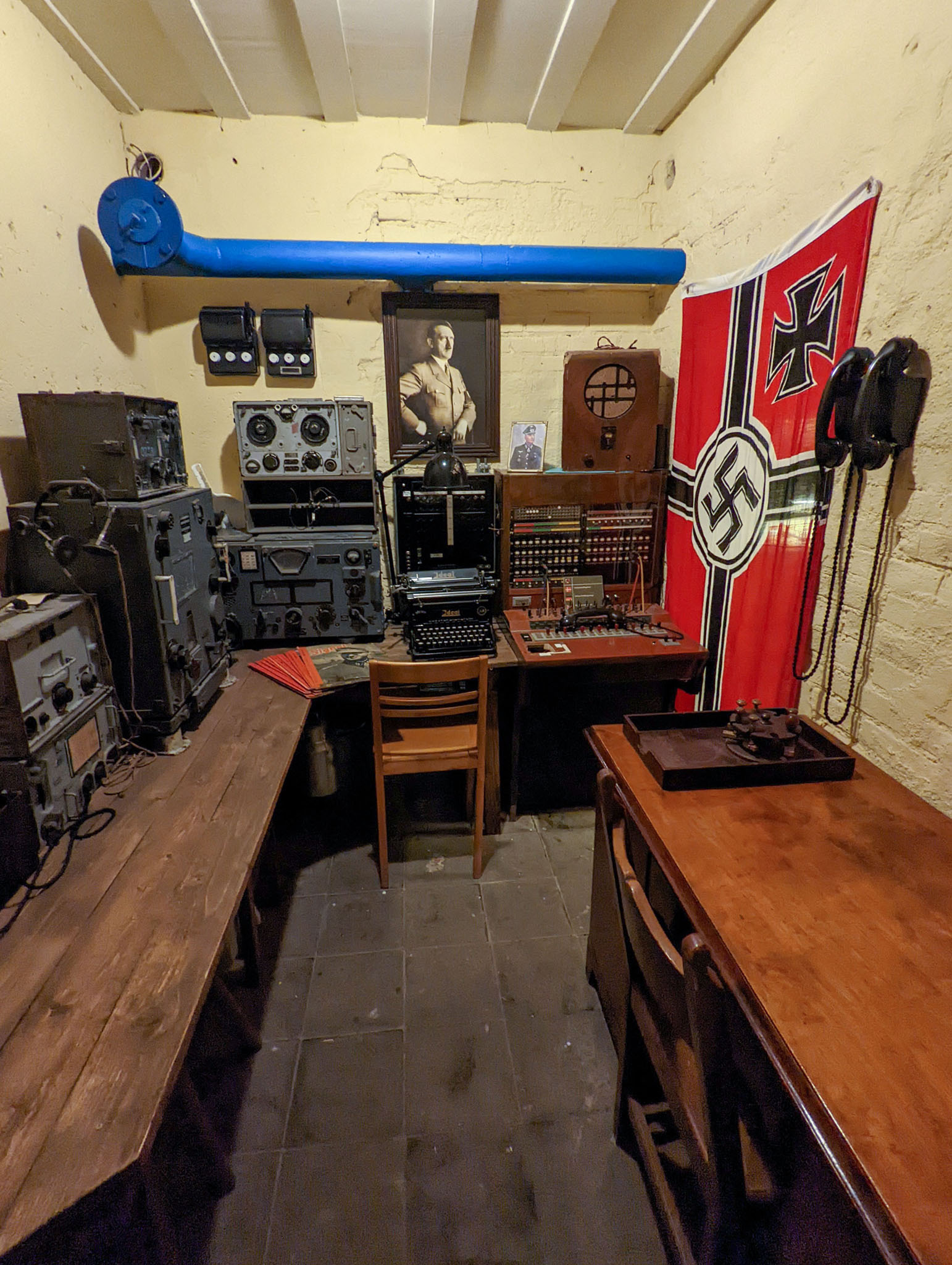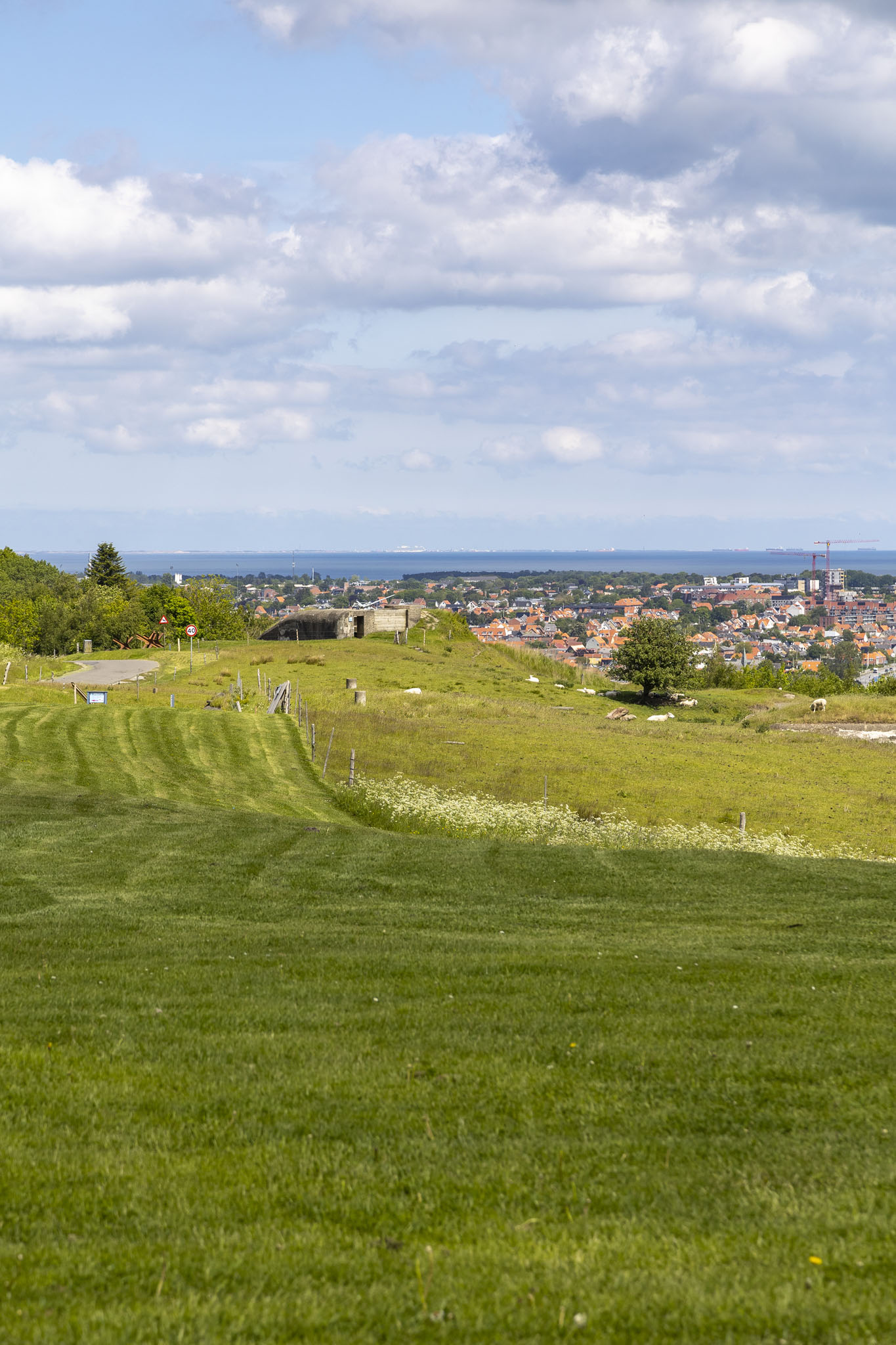For the excursion we’d chosen to go on during our day docked at Skagen on the first of our 2022 cruises on Sky Princess we decided to see something war-related, so after our visit to the Coastal Museum we had a short ride in the bus to the main attraction of the day, Bangsbo Fort Bunker Museum.
Bangsbo Fort was constructed as part of Hitler’s Atlantic Wall defences for Germany’s invading forces during World War II, and its primary purpose was to protect the port of Frederikshavn just to its north which was an important transportation hub to Norway. The high vantagepoint on the cliffs – the bunkers are situated between sixty and seventy metres up – gave it a long range and wide field of view and cover. In total, the Germans laid down seventy bunkers in this clifftop location. A further ten were added after the war by the Norwegians who still maintain overall control of this fort.
After a bit of a look around outside we were eventually led into three of the bunkers that are open to visitors. The museum element of Bangsbo Fort came to the fore here and there were plenty of rooms in the tight spaces with war memorabilia in the form of German equipment, weaponry, mines (deactivated, I hope), and flags. One room was set up how it would have been for the soldiers stationed inside who would have been expected to survive bombing and gas attacks and remain within for some considerable period.
German bunkers were pretty much standardised across a few designs to make their construction easier and quicker so entrances at right angles, steel doors, protected ventilation systems and secure telephones, and emergency escape routes could be found everywhere here, and most likely in any other Atlantic Wall bunker still standing to this day. The Channel Islands contain the best preserved bunkers simply because Hitler considered them the most important (a symbol of taking British land) while the allies considered them strategically worthless and bypassed them completely.
Our guide gave us some warning about the last of the bunkers we visited, stating that it was down a steep slope and steps, and that anyone who wanted to stay up top near the café could do so. Regular readers – or occasional readers who’ve hit the big time and read the few articles where I’ve mentioned this before – will know that my wife has a bit of a reputation with slopes and steps and twisted ankles and knees so I did check with her and she decided to risk it. As it was, the slope was not that steep and the steps were very few. We’d been imagining somewhere out on the cliff edge perhaps but this was like walking down a small, grassy hill, mainly because it was exactly that. We got to pass by the impressive concrete structure of the observation bunker, and as someone with a keen interest in brutalism in architecture, and as someone with a keen interest in cruise ships (which this looked like the bridge of, a little), this was lovely to observe.
The last of the bunkers we visited was actually a gun battery, backed by the manufacturing and storage areas and the delivery rails that would have moved shells to the weapon. Quite how deafening it would have been in here when the gun was firing shocks me to think about it.
During the rapid expansion of the Atlantic Wall defences, getting hold of parts was sometimes an issue for the teams of German engineers so they took what they could from the occupied lands. The gun in place here at Bangsbo Fort came from an artillery ship called the Niels Juel which had been decommissioned in the interwar years before the need for training amidst rising European tensions saw her re-enter service with the Danish navy. Following Germany’s invasion of Denmark, the Danes were allowed to keep their fleet for training purposes, but increased resistance in the population (see the previous post in this series for more about that) led the Germans to suddenly move to seize all the vessels. Niels Juel was able to make a break for freedom but was spotted and attacked by the German fleet leading the Danish crew to attempt to scuttle the ship. This was only partially successful and the ship was eventually refloated, towed for repair, and disarmed.
Is it just me, or does the gun battery at Bangsbo Fort look like an elephant?
One of the weirdly impressive elements of this visit to Bangsbo Fort bunker museum was that as we gathered together at the end of our allocated time we could gaze out from the cliffs and spot our cruise ship docked in Skagen to the north along the coast. The size of the ship compared to the town is stark, and even more so when you consider that the distance between these two points in Denmark as the crow flies is around thirty five kilometres.
A very enjoyable visit indeed, aided by some lovely weather affording us splendid views over land and sea. We always enjoy museums, and if you’re visiting Europe then it’s hard to avoid any of that pesky war stuff since we’ve had a few over the centuries, but why would you want to when it’s all so fascinating?
That brought our organised tour to an end but we were given the option to be dropped off in Skagen on the way back to the ship, and since we had plenty of time before Sky Princess was due to leave that’s exactly what we opted to do. You can read about our look around Skagen in the next post in this cruise travelogue series.















































Did you do this on your own or a tour through Princess? We are cruising on the Sky this summer and would like to see this on our own. Could you tell me how easy it is to get there by bus, train, etc. thanks so much.
This was with Princess. The fort is over forty kilometres from Skagen so using public transport is possible, but not without changes and not without some risk of being able to get back to the port in time, and personally, I wouldn’t advise it. You’d likely have to get the bus or train to Frederikshavn first, then it looks like the number 13 bus would get you up on top of the hill to not far from the entrance to the fort museum. However, the bus doesn’t look to run that often as far as I can see, although that may change in summer months.